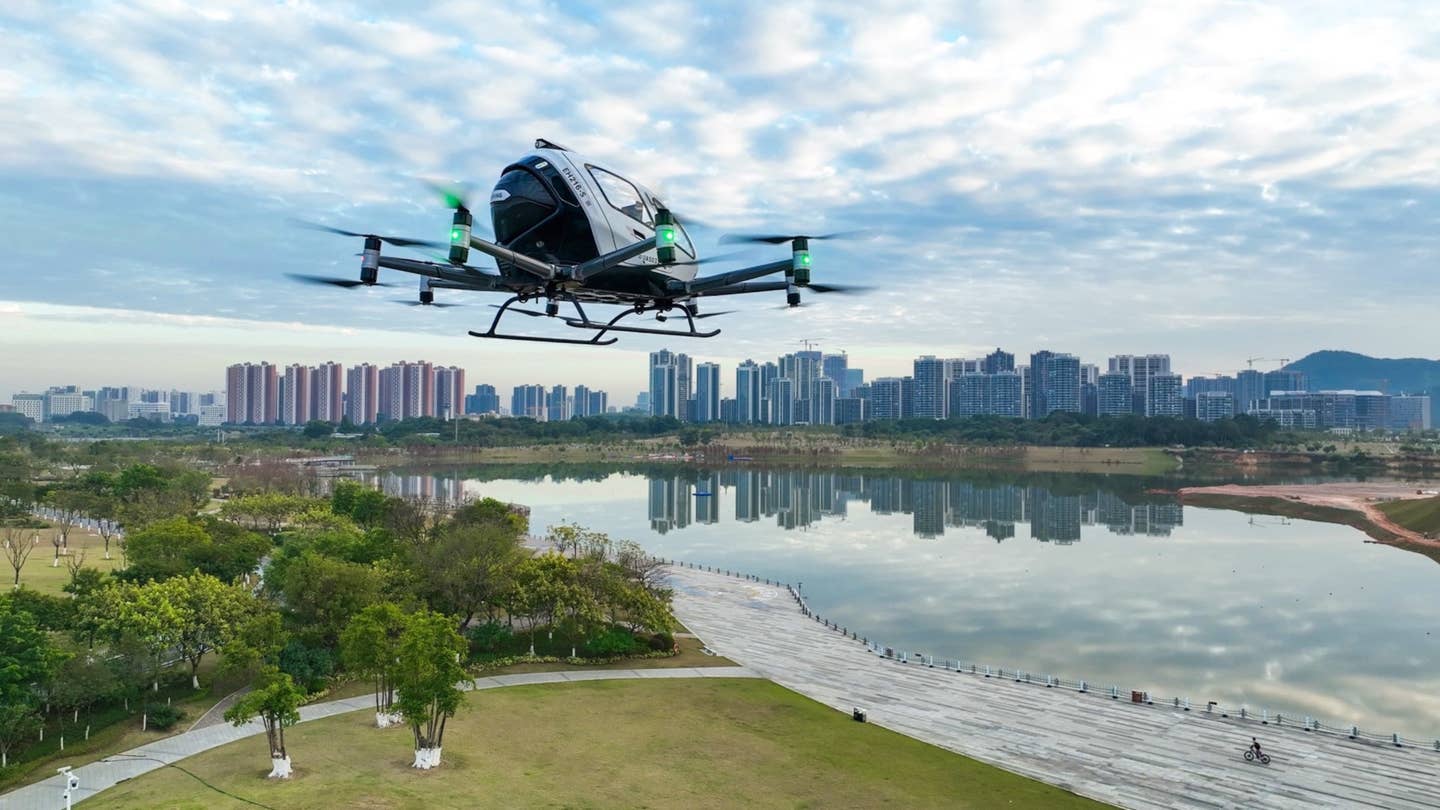Electric Air Taxis Reach Mass Production Phase in China
Electric vertical takeoff and landing (eVTOL) aircraft manufacturer EHang says it now has the trio of approvals necessary to scale up commercial operations in China.

EHang’s self-flying EH216-S completes a commercial demonstration flight at Jiulong Lake Park in Guangzhou, China. [Courtesy: EHang]
Chinese electric vertical takeoff and landing (eVTOL) aircraft manufacturer EHang says it has obtained the world’s first production certification for a pilotless eVTOL design, allowing it to begin mass manufacturing.
The approval was granted by the Civil Aviation Authority of China (CAAC), representatives of which met with EHang founder, chairman, and CEO Huazhi Hu at a ceremony in Guangzhou’s Huangpu District on Sunday.
The event was attended by local government officials, including the district mayor of Huangpu District and deputy mayor of Yunfu City—the site of EHang’s main production facility. The facility is expected to churn out 600 aircraft annually once production scales.
EHang has now obtained production, type, and standard airworthiness certification for its flagship EH216-S: a self-flying, two-passenger design with a range of about 19 nm and cruise speed around 70 knots. The company said the latest approval gives the company “all requisite regulatory certifications” needed to lay the groundwork for commercial operations in China.
“We believe the collaborative efforts of pioneering low-altitude enterprises like EHang and governments, will infuse the industry with momentum and confidence, propelling the low-altitude economy towards a prosperous future,” said Dan Xu, deputy district mayor of Huangpu District.
Autonomous eVTOL aircraft like EHang’s EH216-S are intended to form what Chinese officials have termed the “low-altitude economy.” Similar to the advanced air mobility (AAM) industry being developed in places such as the U.S. and European Union, the low-altitude economy is expected to encompass aerial tourism and sightseeing, emergency medical services, passenger air taxi flights, and other eVTOL-related activities.
EHang in December gave citizens a glimpse of the promised services with commercial demonstration flights in the cities of Guangzhou and Hefei. According to the company, these represented the first passenger-carrying flights by an eVTOL. However, customers flew for free, and the service is not yet routine.
With production certification now joining EHang’s prior approvals, the company is in position to scale up those operations.
“The issuance of the PC [production certification] is pivotal for the EH216-S, as it opens the door to mass production and a crucial step for our advancement towards commercial operations,” said Hu. “With the PC as the starting point, we are poised to gradually expand production and delivery to meet escalating market demands. Our vision is to introduce safe and reliable pilotless eVTOL aircraft to the global market.”
The production certificate is validation from the CAAC that EHang’s mass production quality management system meets the regulator’s airworthiness requirements, authorizing it for mass manufacturing.
The quality management system covers EH216-S’s raw materials, supplier management, production organization and quality control, pre-delivery testing, and post-sale repair and maintenance. The system also enables traceability and safety control to ensure the aircraft rolling off the production line adhere to EHang’s type design requirements, the company says.
CAAC assessed 19 elements of the system and the company’s production capabilities, concluding it has the ability to produce aircraft that will fly safely in Chinese airspace.
EHang says the company is now preparing for commercial operations in China, such as by training personnel and developing EH216-S operational systems. According to the manufacturer, about 20 Chinese provinces are prioritizing the development of the low-altitude economy in 2024, including by enacting favorable policies and regulations, allocating funding and subsidies, and identifying suitable eVTOL takeoff and landing sites.
Recently released CAAC guidance positions the Nansha District in Guangzhou—one of the two cities in which EHang flew in December—as the focal point for the industry. The Guangzhou municipal government has announced several policy initiatives intended to back EHang, while Hefei has committed to invest as much as $100 million.
EHang’s China market entry is also being heavily supported by the central government, which last week released plans for the low-altitude economy through 2030. Beijing’s upcoming initiatives include the construction of takeoff and landing infrastructure, streamlining of airworthiness certification, and improvement of the country’s air traffic management system. The government also called to establish a network of eVTOL demonstration sites, with a particular focus on urban use cases.
EHang, working with CAAC, said it will help establish the world’s first regulatory system and standards for commercial eVTOL operations in the second quarter of this year. Several regulators, including the FAA and more recently the U.K.’s Civil Aviation Authority (CAA), have proposed guidelines for such services, but few, if any, have finalized them.
Throughout 2024, EHang says it will coordinate with multiple governments to build eVTOL vertiports and shape the “benchmark” cities it views as ideal candidates for the low-altitude economy. It intends to launch commercial operation ceremonies for use cases such as aerial tourism and urban air taxis, using its demonstration sites in Guangzhou and Hefei in addition to its urban air mobility (UAM) operation center at OH Bay in Shenzhen.
Like this story? We think you'll also like the Future of FLYING newsletter sent every Thursday afternoon. Sign up now.

Subscribe to Our Newsletter
Get the latest FLYING stories delivered directly to your inbox






